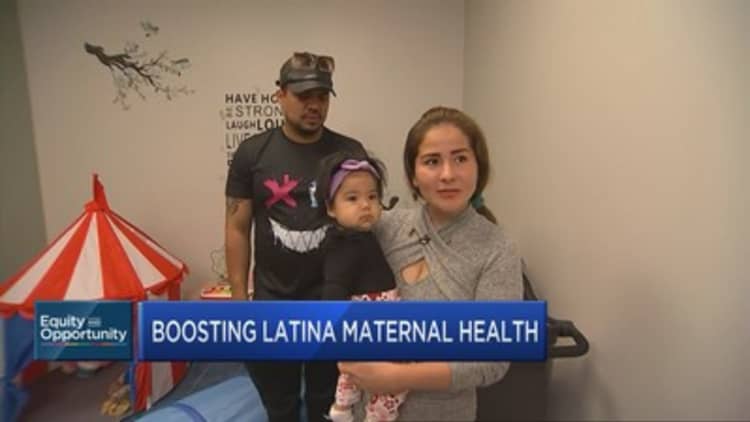
Zaza Cristina Robles worked as a pregnancy coach in her native Peru, so when she arrived in the U.S. at 16 weeks pregnant, the first thing she did after settling in with her in-laws was to seek medical care.
“When they showed us the bill, it was so expensive, my husband and I thought, ‘If this is just for the doctor’s visit, imagine what the delivery will be?’ It scared us,” she said.
Her sister-in-law put her in touch with the Hispanic Health Council, a nonprofit in Hartford, Connecticut. The organization’s Comadrona — or midwife — program helps Latina immigrants and low-income pregnant women navigate the complications of the U.S. health-care system.
“They really helped clear up a lot of my fears,” Robles said.
The program helped Robles gain health-care coverage as she and her husband seek asylum in the United States. Her comadrona helped her find a doctor who treats low-income patients and connected her with other services.
“One of the things that we do here at Hispanic Council is provide birthing classes, in their own language,” said Bianca Noroñas, the Comadrona program manager.
Noroñas said coaching and social services have helped the mothers in the nonprofit’s program avoid medical complications during childbirth.
“If you don’t receive education and support, that is going to affect you directly in your life,” Noroñas said.
In the U.S., the rate of maternal morbidity — medical complications in childbirth — and maternal mortality is nearly twice as high as in other developed nations.
“We’ve been paying a lot more attention to try to understand why these differences persist and why our numbers are so high,” said Marie Thoma, a professor at the department of family science at the University of Maryland School of Public Health. “A lot of investment has been going into addressing some of these factors around the health before, during and after pregnancy that we can improve on in the U.S.”
Latina maternal morbidity and mortality
U.S. maternal mortality worsened during the pandemic, especially for Latinas. According to the Centers for Disease Control and Prevention, the U.S. saw 23.8 maternal deaths per 100,000 live births in 2020, up 18.4% from 2019. For Black women, the maternal mortality rate jumped 25%, while for Hispanic women it surged 44%.
While researchers are not clear on why Latinas saw such disproportionately higher mortality rates in 2020, the overall trend in the U.S. has been that women of color have had poorer outcomes in childbirth.
Latinas with private insurance plans have a 22% higher rate of severe pregnancy complications than non-Hispanic white women, according to a Blue Cross Blue Shield Association study. Low-income Hispanic women on Medicaid have a 28% higher rate of complications.
Higher rates of obesity and chronic conditions such as diabetes among women of color can play a role in maternal morbidity. Financial barriers to getting proper care also contribute to poorer outcomes for Black and Hispanic women, as well as cultural barriers in health care, said Hispanic Health Council board member Dr. Yvette Martas.
“It is the issue of being listened to,” said Martas. She said the health-care system needs to support mothers beyond the delivery room, “creating the culture where this is not a disease model, but it’s a very natural course of how we reproduce.”
High costs spur investments
An analysis by the Commonwealth Fund calculated that the cost of maternal and child morbidity for U.S. births in 2019 reached $32.3 billion from conception through the child’s fifth birthday. That amounts to an additional $8,624 for each mother-child pair, according to the researchers.
Health insurers and large employers such as Walmart have taken note of the problem. This year, Walmart expanded coverage for pregnancy-support programs to workers in four states by providing up to $1,000 for doula services.
Through its pregnancy-support initiative, Blue Cross Blue Shield of South Carolina has seen maternal and infant morbidity rates decline substantially. The insurer’s Centering Pregnancy program has cut the rate of newborns needing to go into the neonatal intensive care unit from 13.9% to 3.5% — at an average savings of $67,000 on NICU costs.
“I think offering doula programs and offering paid leave — there’s a lot of things that I think our companies can do … that could really support moms during and then just as they return to work,” Thoma said. “It will give back to the company as well.”
Beyond pregnancy, the Comadrona program also offers postpartum support. Robles said she got help with diapers and lactation coaching.
“Thank God … It turned out well for us and they cared for us so well,” said Robles, whose delivery had no complications.

